You’ve driven in snowy conditions hundreds of times. But one evening on your way home, the snow that was supposed to be manageable is suddenly building up fast.
That’s what happened in Buffalo, New York in December of 2022, when the Buffalo Niagara International Airport reported 49 inches of snow in one weekend. “It was like looking at a white wall for 14 to 18 hours straight,” a county official said. Some people were stranded in their cars for two days, and rescue personnel were unable to reach them.
It's cases like these that highlight the need for a winter emergency car kit. Even if you don’t live near a great lake and probably won’t face such a dire situation, it doesn’t hurt to be prepared for winter weather emergencies, like an accident that strands you on the side of the road at night.
Items you should have and why they’re important

Some of the items for your winter emergency car kit are recommended for safety all year around, not just winter, but they’re doubly important during the coldest season.
- Blankets, snow or rain jackets, and extra clothes - Keeping an extra blanket in the car is a basic precaution for many scenarios. And if you need to shovel your car out of a snow drift or parking lot, having an extra pair of pants and socks means you won’t be stuck in wet and cold clothes for the ride home.
- Water and food - Stay hydrated! Keep a couple of bottles of water in the back seat, and stick some granola bars or beef jerky back there, too, just in case. If the worst happens and you’re stuck for a long time, having water and food on hand can help you keep your head and give you the strength to walk to safety.
- First aid kit - Bandaids, headache medication, toiletries, and extra medication (like an inhaler) are helpful to keep in stock all year round. When winter hits, check that your supplies are full, and none of the items or medications have passed their expiration date.
- Jumper and charging cables - In the cold, batteries lose their charge faster than in higher temperatures, but a dead battery can happen at any time. You may need to give a friend a jump, or ask for one yourself. Keeping jumper cables handy allows you to help yourself or someone else.
- Flashlight - If you’re stuck and need to walk to get help, or need to see under the car to make repairs, a flashlight is invaluable. They’re cheap and easy. Stick one in your glove compartment and regularly check the batteries.
- Flares or other emergency signals - A little pack of reflective triangles will give other drivers the signal to steer around your car if you’re stuck, and flares can help emergency personnel locate you. Buy a kit once and don’t worry about it–you might be glad you stashed it ahead of time.
- Phone charger and cable - Your phone is your most powerful tool in any emergency to let rescuers know where you are. Don’t get caught with a dying phone. Keep at least a cable, if not a portable charger.
- Chemical hand/foot warmers - These little packets of chemicals are a must-have in any winter safety kit. The chemicals react to the air and heat up when you shake them. They last for hours, and can go into your shoes, gloves, or anywhere else you need them.
- Windshield scraper and shovel - There are many kinds of windshield scrapers, but you don’t need a fancy one to chip the ice off your front window before work. Shovels come in handy if snow came through while you were stuck in a meeting, but the plows have cleared the roads. Dig yourself or someone else out so you can get to where you need to go.
- Rain-X - If you don’t want to stand outside scraping your windshield when you wanted to be on the road thirty minutes ago, keep a gallon of Rain-X in your car. It can help de-ice your windshield, and will keep your windshield clean and clear in adverse conditions.
- Sleeping bag - A step up from blankets and jackets, a sleeping bag will help you preserve heat if you need to wait through the night or day for help. Many sleeping bags will be rated by minimum temperatures. The lowest temp the sleeping bag is rated for generally will keep you alive, but not necessarily comfortable.
- Traction boards, sand or kitty litter - Traction boards get shoved under tires that are spinning against mud or ice to provide enough traction to get the car out of that spot. Sand or kitty litter can help in the same way. Keeping these handy will help you and your neighbors get out of the muck.
- Tow strap - You may need to help someone or yourself get out of a sticky situation. Tow straps allow you to move fallen trees or pull other cars to safety. Aim to have a tow strap that’s 25 feet with sewn end loops, rather than riveted. You can also use a chain. Make sure you know how to secure your chain or tow strap at both ends.
Cost of winter safety items
The cost of these items range from traction boards that will set you back $102, to a pack of hot hands for just $7. Blankets and sleeping bags can be found cheaply at thrift stores or yard sales or a local store. Road safety kits with many of the items on this list (reflective triangles, shovels, basic first aid, jumper cables, flashlights) can be found for around $44 dollars. You can source many items individually from automotive stores, box stores like Walmart, or other online sources. You may even have some of the items in your own home.
Other strategies you can employ while driving in winter
- Check the weather before you head out.
- Stay cautious–it’s better to stop and spend the night in a hotel than the side of the road
- If you slide on ice, don’t hit the brakes! Stay calm, and let the slide come to a natural conclusion. Hitting the breaks can cause your car to fishtail, and send your car out of control. Try a gentle pumping motion on the brakes if possible, but not a hard slam. Don’t panic.
- If you have bad visibility, slow down, and put your hazard lights on.
Decisions to make
Remember that you may need to get yourself to safety instead of waiting for rescue because waiting for rescue personnel might be the more dangerous option. If you’re new to the area, ask friends, colleagues, or message boards about what items are good choices. Choose the items to have in your car that will help you the most based on where you live, where you drive, and the weather conditions you’ll face. They could end up saving your life! For other road safety tips, RateWorks has you covered. Check out our insights blogs for more.


.webp)









